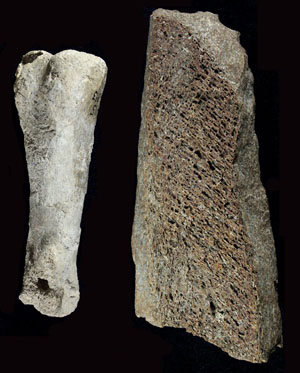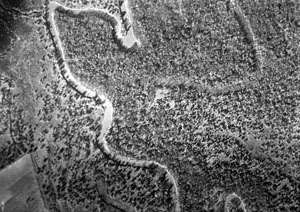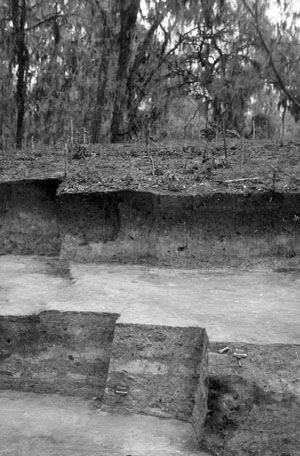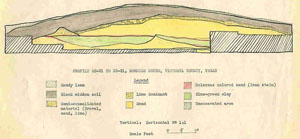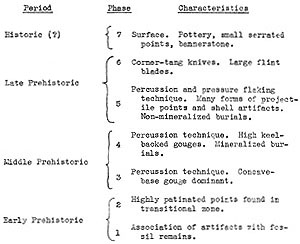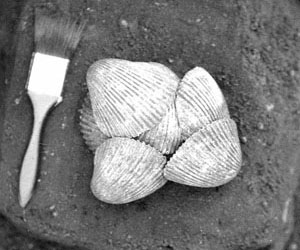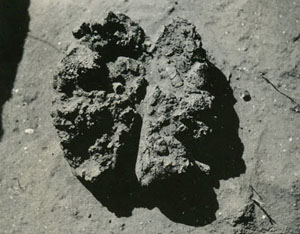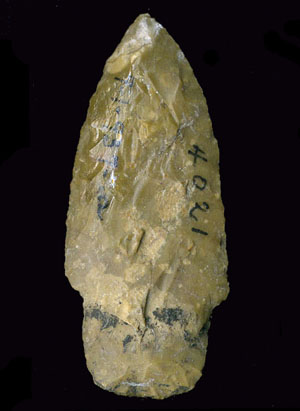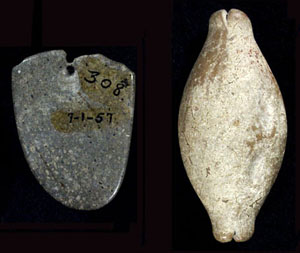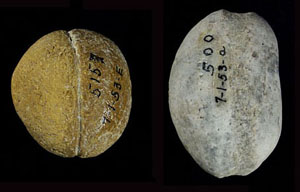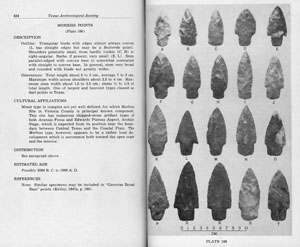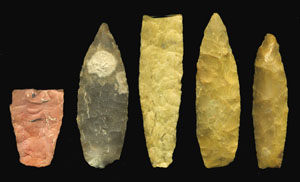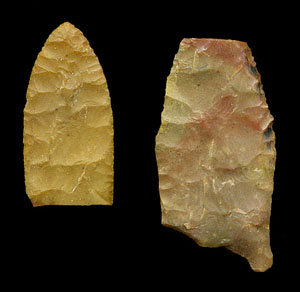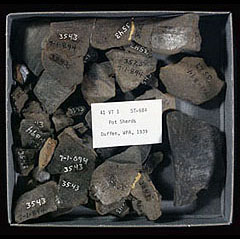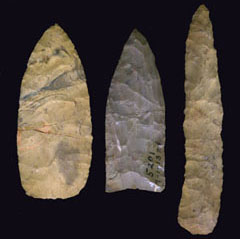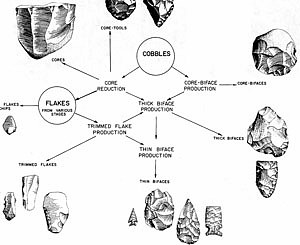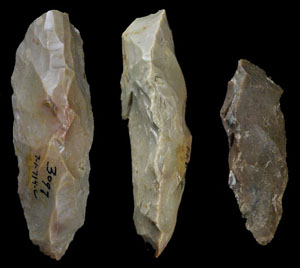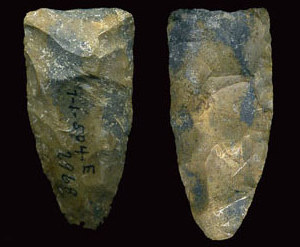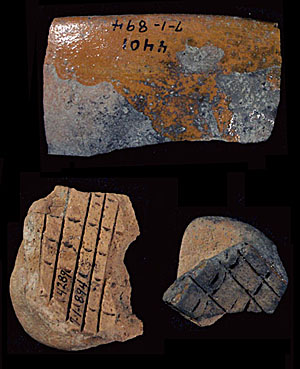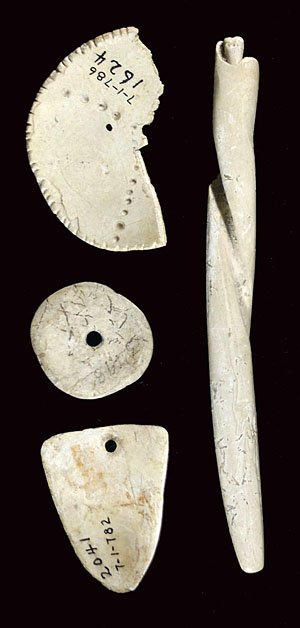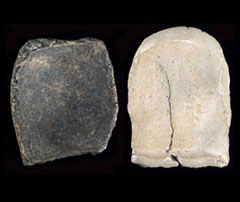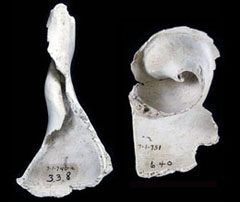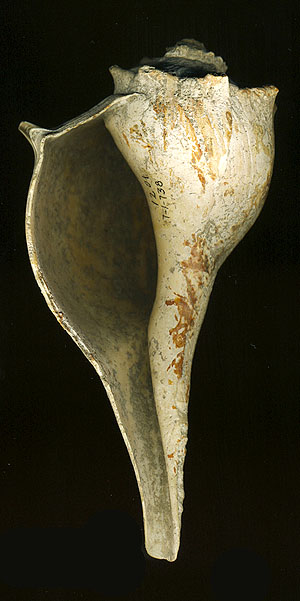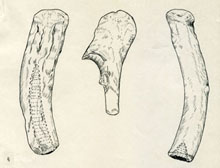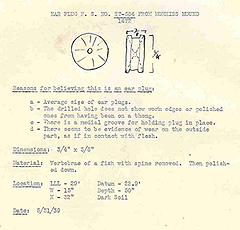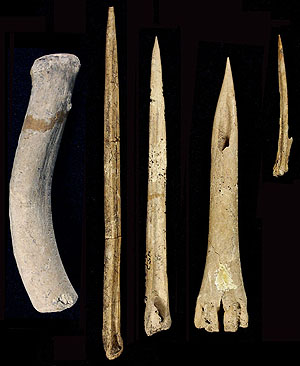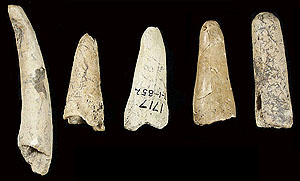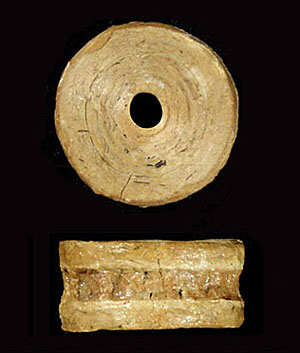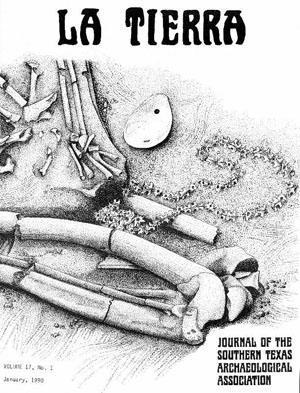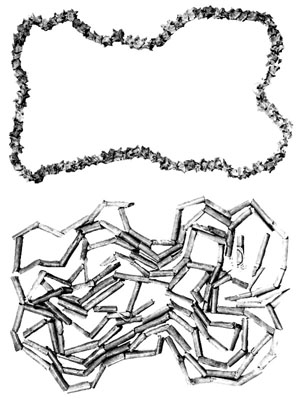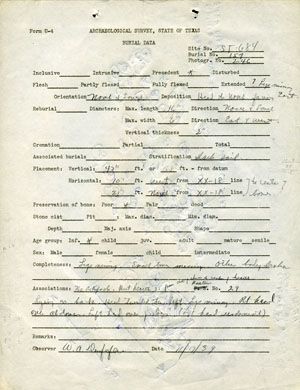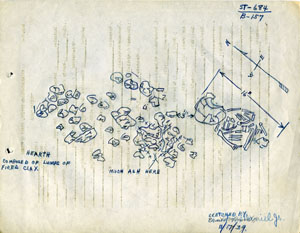Evidence |
|

This photographic collage shows an exposed cross-section (profile) through Morhiss Mound. Although the original WPA photographs are not preserved, a pieced-together negative exists that was newly scanned to create this image. TARL Archives. Enlarge |
|
Through time, the ancient Deweyville Terrace was eroded and shaped by the meandering Guadalupe River and its tributaries. By roughly 12,000 years ago, if not before, a distinct knoll had formed, a “terrace remnant” in geological terms. Periodic floods continued to shape and erode the knoll and sometimes add newer sediment layers. The ancient knoll was capped by a relatively thin layer not much more than a foot thick of sand and gravel within which were bones and some artifacts, many of them heavily patinated (chemically weathered) and covered with calcium carbonate encrustation. The archeologists termed this the transition zone because it contained both fossil bones and the bones of still-living animals as well as a few man-made artifacts. The artifacts included a few Late Paleoindian points, most of the Angostura type, but several others as well, including a fragment of a Midland point that dates to some 12,000 years ago (10,000 B.C.). By the dawn of the Early Archaic some 9,000 years ago, the eroded terrace knoll became a favored campsite, establishing a cultural pattern that continued for over 8,000 years. A dark, organic-rich layer formed, which the archeologists called a midden deposit. This thick deposit of sandy loam ranged from a few inches thick at the outer edges of the knoll to about 12 feet thick in the center of the mound. Similar midden layers are found at many Archaic and Late Prehistoric terrace sites where people often camped along the Guadalupe River. Such midden deposits are accumulations of both cultural materials—camp debris such as ashes, charcoal, discarded plant remains, animal bones, hides, etc.—and natural organic materials—rotting leaves and such. It is likely that the Morhiss midden also incorporated fine sediments deposited as thin layers during particularly high floods. If so, no obvious evidence of flood deposits was recognized and it is to be expected that such thin lenses would have soon become mixed within the midden as people returned to the site, trampled around, dug holes, built fires, and so on. The knoll was within the dense wooded bottomlands along the river and it was doubtlessly covered by trees and undergrowth except for areas that people must have cleared off for camping and other activities. Most likely they cleared around larger trees and left these standing for shade and perhaps to help support temporary shelters such as lean-tos. The river’s position relative to the knoll likely changed during the last 10,000 years (the Holocene or recent geological period), probably several times as the Guadalupe migrated (meandered) through its sediment-filled valley. One such meander scar (relict channel) is obvious in aerial photos and topographic maps and passed within a few hundred feet of the knoll. The timing and dating of the river meanders in this section of the Guadalupe are not precisely known. The great majority of all artifacts, features, and human burials were found within the dark thick midden at the Morhiss Mound. The WPA archeologists saw the midden layer as a single deposit because they did not recognize any internal layering. But most of the digging was done quickly by untrained laborers using picks and shovels. It is likely that some surviving traces of internal depositional layers, from minor floods as well as human activities, could have been recognized in places within the mound using modern excavation techniques and geoarcheological investigation. But most of depostional layering would have been mixed and obscured by both natural processes, such as tree roots, insects, and burrowing animals, as well as cultural processes such as digging pits for burials and other purposes. By far the most commonly noted disturbances were rodent burrows, most of which were created by pocket gophers and most of which were probably relatively recent in age. Duffen recognized that there were some recognizable changes in artifact styles and burial practices over the considerable time during which the site formed. In fact, he sketched a basic chronological outline with four periods and seven phases that is among the first such developmental charts that anyone devised for an archeological site in Texas. This provisional scheme was based on his observations and documentation of where certain types of artifacts and certain types of tool-making technology occurred within the site. This ahead-of-its-time thinking underscores the loss to archeological progress that occurred because he wasn’t able to complete the analysis and reporting of the Morhiss site. It would take decades before archeologists would put forth an improved scheme for the lowerGuadalupe Valley. Duffen’s prescient insight seems to have gone unnoticed by later archeologists, unpublished and forgotten. |
|
FeaturesThe WPA archeologists documented 42 cultural features, not counting the burials. This too was an improvement over earlier excavations during the Pearce-led era when similar features were sometimes mentioned in passing, but very rarely documented. The Morhiss features included about 25 recognizable hearths as well as caches of artifacts and sea shells, two small piles of oyster shells, and two large masses of asphaltum. One suspects that these were only the most obvious features and that there were very likely many other more subtle patterns such as charcoal stained patches, small burned rock clusters, and concentrations of artifacts and animal bones, that would be recorded and sampled as features today. Nonetheless, the formal documentation of 42 features represents an important step forward for archeological investigation. Each feature was assigned a feature number, described in the field on a printed feature form, sometimes sketched, and further documented by a photograph of the fully exposed pattern. |
|
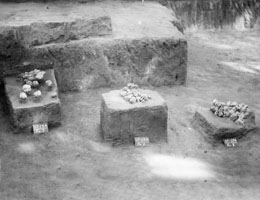
|
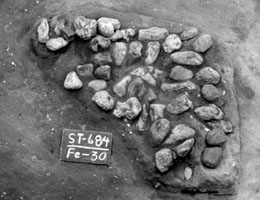
This cluster of river-rounded rocks (Feature 30) may represent baking stones arranged as a hot-rock bed and capped by an earth oven. In fact, most of the "hearths" recognized at Morhiss probably represent the same type of cooking, pattern that has been documented in many areas of North America. TARL Archives. |
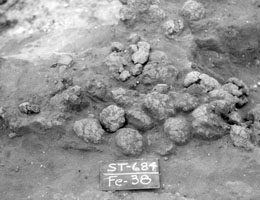
This cluster of baked clay balls is an obvious example of the use of baked clay as a substitute for cooking stones. When heated, grapefruit-sized "balls" of wet clay were transformed into crude ceramic objects that could hold and slowly release heat for baking, just like heated pieces of sandstone and limestone. Similar artifacts have been found at many sites along the Gulf coastal plains where stone is hard to find. The same function is attributed to "Poverty Point Objects" (shaped pieces of baked clay) found at the famous Poverty Point site (ca. 1500-800 B.C.) in Louisiana. TARL Archives. |
|
The 25 hearths included intact relatively small, roughly circular or oval patterns of closely spaced sandstone cobbles and rounded balls of baked clay as well as a few scattered patterns and one small group of closely spaced sandstone slabs. From today’s perspective, most of the “hearths” probably represent the heating elements or “oven beds” of small earth ovens, a pattern now known to be characteristic of Archaic sites in much of Western (and probably Eastern) North America. Of particular interest is the use of baked clay balls. In the 1930s, and for decades thereafter, archeologists debated how baked clay balls formed and whether they were used as substitutes for baking stones (“burned rocks”). The photographic evidence from Morhiss provides very clear examples of this pattern. As can be seen most clearly in the photographs of Feature 38, the clay balls were unnaturally rounded, grapefruit-sized, round to oval masses and these were packed together just like the stone “hearths” – earth oven beds. The fact that some hearths at Morhiss contained both rocks and baked clay balls reinforces the functional equivalence. Among the features were at least 10 caches of various materials including stone tools, unworked flint cobbles, and marine shells. These tight clusters of artifacts apparently were not directly associated with burials, although it is not known whether they were cached for later use or as offerings. Similar caches have been found in the region in cemetery sites such as Loma Sandia as well as in isolated circumstances (see Biface Caches). The caches of asphaltum suggest storage for later use as a hafting adhesive; over 70 dart points and stone adzes were said to have traces of asphaltum in the areas of the tools where they would have been affixed to wooden handles or shifts. In one case a mass of asphaltum was buried with two flint knives, several bone awls, and antler flaking tools; this would seem to be a tool-making cache. Stone Tools and PotterySome 7000 artifacts were recovered from Morhiss during the WPA excavations and most of these were stone tools. As Campbell noted, this is a comparatively small number given that 5,000 squares were excavated, less than 2 artifacts per square dug and even the most prolific squares had no more than 8-10 artifacts. On the face of it, the site would seem to have had a very low artifact density, but several factors must be considered. First, during the WPA work, only relatively complete and “recognizable” artifacts were counted and collected as artifacts. Further, these were collected by hand as they were spotted by the workers; the excavated soil was not screened as is almost always done today. Therefore, most small tool fragments and all pieces of chipping debris were routinely discarded, as were most animal bones, charred remains, snails, and other kinds of evidence that are routinely collected and accounted for today. Second, the 5,000 squares were dug to varying depths and some were situated on the thin outer edge of the mound and beyond. These factors make it all but impossible to meaningfully compare the artifact density within the Morhiss site to that documented by modern excavations at other sites. The WPA did have a well-organized laboratory in San Antonio where most of the artifacts from Morhiss and other Texas excavation projects were taken from the field and processed. While the WPA field crews consisted only of men, the WPA lab workers included women as well. All of the artifacts and human remains from the Morhiss excavation were carefully cleaned, labeled, inventoried and later sorted into categories. Unfortunately, many of the categories and descriptive terms used by the WPA are not of much use today. In 1940, little was understood about lithic technology and most of the variability of stone tool forms and styles was not recognized by most. Stone tools were seen as primitive artifacts created by primitive peoples. General similarities among Archaic dart points, for instance, caused early archeologists to lump most together and ignore the considerable stylistic variation. In some areas of North America, particularly those where “higher cultures” had existed that lived in permanent settlements and made pottery, such as Mesoamerica and the American Southwest, archeologists were making progress in sorting out and understanding artifact variation. Less had been accomplished in Texas and a workable classification scheme would not exist until the mid-1950s. |
|
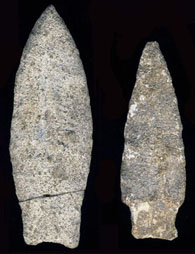
|
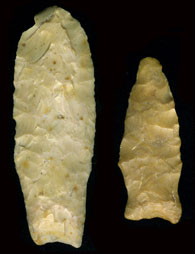
|
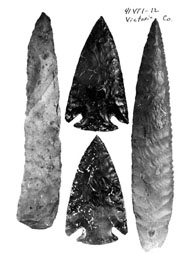
|
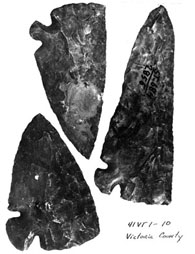
|
|
Among the recognized and collected artifacts from the Morhiss Mound site are many projectile points, bifacial knives and preforms, and stone adzes, as well as scrapers, drills, hammerstones, and various other tool forms. As said, these have yet to be systematically studied and accounted for using a modern classification system. Yet, the Morhiss collection was well known and often consulted by Texas archeologists of the 1950s when classification systems were being worked out. Among those who examined the collections and sorted at least the projectile points into provisional or established groupings were J. Charles Kelley and Alex D. Krieger, both of whom were well-educated archeologists who had come to the University of Texas in the 1940s in the waning years of the WPA. Kelley led some of the later WPA excavations, particular those along the Colorado River west of Austin. Krieger came a bit later, after the WPA field projects had ended. He was assigned to follow up on some of the most important WPA projects, most notably that of the George C. Davis site in east Texas. Krieger continued to work for the University on federally sponsored projects after the WPA era ended. Unfortunately, Kelley and Krieger apparently viewed each other as competitors and did not get along. The history of this era of Texas archeology deserves to be properly told, but that would require a book-length treatment. Of interest here is the fact that both Kelley and Krieger devised their own classification schemes and both made reference to the Morhiss collection. Although it is obvious that both were quite familiar with the collection, neither published anything on the Morhiss site materials except indirectly, and whatever analytical notes each may have kept on the Morhiss collection do not appear to have survived. Kelley’s classification scheme was never fully published and his approach did not take hold. In contrast, the 1954 publication of An Introductory Handbook of Texas Archeology by Suhm, Krieger, and Jelks established many of the named artifact types that are still used today. Archeologist Richard Weinstein has pointed out that many projectile points from the Morhiss collection were illustrated as representative examples of the newly defined projectile types that Krieger and his colleagues set forth in the Handbook. In the 1954 volume, photographs of Morhiss artifacts appear as examples of no fewer than 13 named dart point types ranging in age from the Late Paleoindian Plainview and Meserve types to the Transitional Archaic Ensor and Fairland types. One of the newly named types was named the Morhiss dart point, a style that was then known from few other sites. Today the Morhiss point is known to date to the Late Archaic period and is mainly found at sites within the lower Guadalupe River drainage basin in the eastern South Texas Plains. Artifact typology, of course, is an ongoing process. Types are not “once and forever” categorizations, but simply best-guess descriptive groupings based on available data and that are subject to revision and reappraisal. The artifact type descriptions, Part II of the 1954 Handbook, were revised by Suhm and Jelks and published by the TAS in 1962. In the intervening decades many new artifact styles have been described and some of the existing ones have been revised. Typology is not an end into itself, but simply an analytical tool that is used to help address research questions and allow effective communication. Campbell’s 1962 appraisal of the Morhiss site summarizes the major artifact forms and types present in the collection and adds some observations. For instance, among the lanceolate dart points, he recognized 10 or 12 points similar to the Angostura style, and noted that “a few points look Plainview in outline, but lack grinding and show rather crude flaking.” The Angostura type is now considered by most to date to the onset of the Early Archaic period and tightly dated at several sites at about 7,000 to 6,800 B.C., although the style is thought to first appear as early about 7,900 at the Wilson-Leonard. It is doubtful as to whether Paleoindian experts today would regard any of the lanceolate points from Mohiss as examples of the Plainview type. This uncertainty also makes plain the need for a thorough reappraisal and publication of the Morhiss collection. There are several Paleoindian points that suggest the first visitors were considerably earlier than Angostura times. There is at least one classic Golondrina point, which has been dated elsewhere in Texas to about 8,000 B.C. And there is a distal section of a very thin, very well made parallel-sided lanceolate point that closely resembles the Midland type. This type co-occurs with Folsom points around 10,000 B.C. The incomplete specimen from Morhiss hints that humans first set foot on the site during Early Paleoindian times some 12,000 years ago. |
|
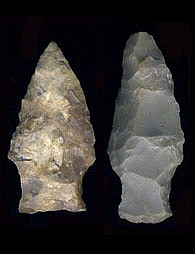
|
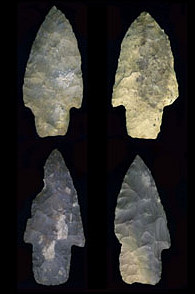
|
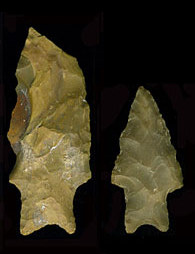
Quite a few Pedernales dart points were present at Morhiss.
This style dates to the Late Archaic (ca. 1000 B.C.). Although considered a classic central Texas type, the style occurs widely. Those from the Morhiss site include preforms, minimally retouched, and
heavily retouched examples. TARL Collections. |
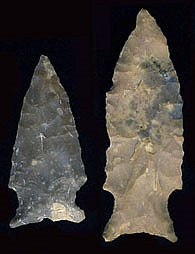
|
|
Here we provide some recent and WPA period photographs of a small selection of the Morhiss artifacts and offer a few comments within the captions and below on some of the most common types and most telling patterns. The bulk of the projectile points are dart points dating to the Middle and Late Archaic periods according to the current chronological scheme devised for the eastern Edwards Plateau (see Eastern Plateau Prehistory). As archeologists have long recognized, many of the stone tools from the Morhiss site closely resemble those that are characterstic of the eastern Edwards Plateau and adjacent areas of central Texas. This is not surprising because the Guadalupe River originates there and it is clear that in prehistoric times the Guadalupe Valley was a transportation route between central Texas and the coast. Among the dart point styles found at Morhiss that are usually identified with central Texas are the Uvalde, Nolan, Travis, Bulverde, Pedernales, Marcos, Lange, Ensor, Fairland, and Darl types. There are also numerous specimens of unstemmed styles that are commonly associated with the South Texas Plains including the Tortugas, Abasolo, Refugio, Lerma, Kinney, and Matamoros types. There are other points, especially those of the Morhiss type, that mainly occur within the lower Guadalupe drainage system. Archeologist Daniel Fox studied dart points from the proposed, but never built, Cuero I Reservoir area along the Guadalupe River some 30-30 miles upstream from Morhiss Mound. He realized that many Archaic dart point styles common in the lower Guadalupe Valley were made using a cobble reduction technique. In contrast, further up the Guadalupe on the Edwards Plateau the same styles were made using a flake reduction technique. In cobble reduction, the knapper makes the dart point directly from a whole cobble, whereas in flake reduction the point is made from a large flake.This technological difference reflects the available raw material. The chert (flint) cobbles available along the Lower Guadalupe are generally relatively small in contrast to the large tabular cobbles and nodules of high quality chert found in many areas of the Edwards Plateau. It is very likely that the core reduction method was the predominate technique used at Morhiss Mound as well. There were also many other types of chipped stone tools in the Morhiss collection including knives, bifacial chopping tools, scrapers, drills and adzes. Among the knives, Campbell noted “quite a number of long, narrow, triangular knives that are very beautifully chipped.” There were also at least three corner-tanged knives, a specialized artifact type that is often found in cemeteries and in caches that date to the Late Archaic. Most of the corner-tangs found in the South Texas Plains are characteristically made of Edwards chert and are thought to represent trade items originating in central Texas. The stone adze types present include Clear Fork and Guadalupe tools (also called gouges), of which many examples and several varieties were found. Most of these probably represent wood-working tools and have parallel forms that are made from shell. The preponderance of wood-working tools is discussed in the Morhiss Revisited section. Ground stone tools found at Morhiss include ordinary food processing and tool-making tools such as manos, metates, abrading stones, and a stone pestles, as well as more unusual items including pendants (or gorgets), bola stones, a stone plummet, and a bannerstone fragment. Most of the uncommon items were associated with burials and are similar to specimens found in the Early Archaic cemetery at Buckeye Knoll, a recently excavated site about 5 miles downstream from Morhiss Mound. The bannerstone, pendants, and the stone plummet suggest that Morhiss inhabitants participated in a social network with far-reaching extra-regional contacts to the northeast and east within the Eastern Woodlands. Although the bulk of the time-sensitive artifacts found at the Morhiss site date to the Archaic, artifacts dating to the Late Prehistoric were found in the uppermost deposits. These include Scallorn and Perdiz arrow points and several dozen prehistoric pottery sherds. There are also hints that the Morhiss site was occupied, even if briefly, during the Spanish Colonial era, probably the 18th century when Spanish missions and presidios existed in the Victoria area. These early historic artifacts include Mexican glazed earthenwares and unglazed ceramic sherds are reminiscent of molcajetes or grater bowls.
|
|
Shell ArtifactsThe marine and freshwater shell artifacts from Morhiss are better known as these have been the focus of detailed analysis (see Dockall and Dockall 1996 The shell pendants (or gorgets) are larger, more diverse, and were more difficult to make. Most were fashioned from Lightning Whelk (conch, Busycon perversum) shell or from marine and freshwater bivalve (clam) shells. Although whelk shell pendants take several forms, most of those found at Morhiss closely resemble artifacts known from Late Archaic cemetery sites in the Western Gulf Coastal Plain. Many of the shell pendants from Morhiss exhibit design elements dominated by scored lines and drilled punctuations (dots). One unusual pendant recovered from Morhiss is a shell disk having a central perforation and three sets of incised horizontal lines. An almost identical specimen was recovered from the Olmos Dam cemetery in Bexar County. These design elements are similar to other Archaic sites along the West Gulf Coastal Plain and could indicate group participation within a broader belief or social system. In addition to formal shell ornaments associated with burials there were also several small caches of marine shells that were documented as features. Similar shell caches occurred at the Loma Sandia cemetery. Shell artifacts were associated with approximately 10% of all burials at Morhiss, and had age and gender associations similar to those of other Late Archaic cemeteries such as Ernest Witte, Crestmont, Blue Bayou, Olmos Dam, and Loma Sandia. Among these sites, shell grave goods were interred more often with adults than children and typically occurred with both adult males and females. Although no female burials were identified at Morhiss that were associated with shell artifacts, this is most likely due to the fact that most skeletons were not preserved well enough to identify gender. Morhiss had a greater number of burials for which sex could not be determined than other Late Archaic cemeteries. The Morhiss collection also includes about 200 shell tools, some which were associated with burials and others found scattered within the midden. These include a variety of forms that are functionally similar to some of the stone tools. Tool types consist of two forms of whelk shell hammers, three types of whelk shell adzes, and assorted cutting and scraping tools manufactured from marine and freshwater bivalves. Bivalve cutting tool forms are represented by notched and unifacially retouched tools. Whelk shell hammers of both types exhibit characteristic battering and polish from use. |
|
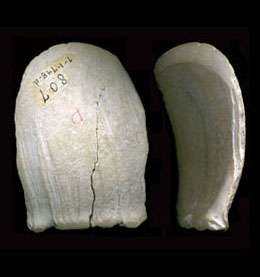 This style of shell adze is the most common of the three types of shell adzes
recovered from midden deposits at 41VT1. It is manufactured from a rectangular section of exterior
whorl from a conch shell. The proximal or bottom edge of this adze exhibits a portion of the
ornamental ridge where the exterior whorl and the shoulder of the spire meet. Note that the ridge
has been partially ground, probably to facilitate hafting. The scooped or spoon-shaped cross-section
reflects the natural character of the shell. Lateral edges exhibit some chipping and smoothing,
probably also to facilitate hafting of the adze. Also note the very well-shaped cutting edge
characteristic of this adze type. Note the general morphological similarity of this shell adze type
to Clear Fork tools. The similarity may suggest a similar range of functions.
|
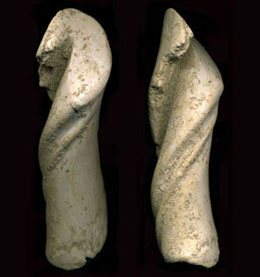
This photograph portrays the second most numerous shell adze from the Morhiss
site. These adzes were manufactured from the interior columella obtained from large horse conch
shells procured from the Texas Gulf Coast. Once the columella was procured a section of suitable
length was removed by either the groove and snap technique or direct percussion. The cutting edge
or bit was shaped by grinding and the proximal end was roughly prepared by light smoothing or
grinding. Note the general morphological similarity of this shell adze type to the Guadalupe biface
or adze. Again, the similarity may suggest a similar range of functions.
|
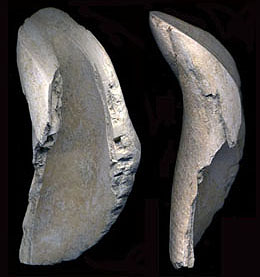 This photograph depicts the third type of shell adze recovered from Morhiss.
This type of adze is not currently known from other sites along the Texas Gulf Coast. Interestingly
this adze type is manufactured from the end of the conch shell that terminates in the siphonal
canal. It is not known how these small adzes were hafted but the cutting edge or bit was created in
a similar manner to the second shell adze type manufactured from the internal columella. Only three
specimens of this type of adze were recovered from 41VT1. That these are not bit fragments of broken
adzes is suggested by the presence of light grinding and smoothing along all broken edges.
|
|
Wear and fracture patterns of beveled shell adzes indicate that these implements were typically hafted and were probably used as wood-working tools in a manner similar to Guadalupe and Clear Fork tools. Microscopic “wear pattern” study showed that the beveled shell tools had fracture patterns, battered edges, striations, polish, and impact damage similar to wear types documented for beveled stone tools. Similar shell implements have been documented at many Archaic coastal sites such as those along Oso Creek, which empties into the Nueces Bay system near Corpus Christi. The presence of diverse types of shell artifacts at an inland site like Morhiss suggests that the groups who frequented the site were quite familiar with the coast and doubtlessly spent part of their yearly round there. Most of the shell artifacts were probably made at the coast and brought to the site in finished form or perhaps as preforms requiring only grinding or decoration. This makes sense because it did not require hauling quantities of marine shell up the Guadalupe River at least 20 miles inland, and twice that distance to the Gulf strandline where most of the shells were most easily found. The early stages of manufacture of both stone and shell tools would have resulted in a relatively high failure rates, and there are only a few candidates for failed shell tools at Morhiss.
|
|
|
That said, there is some shell debris at the Morhiss site that appears to be the byproduct of the manufacture of shell tools or ornaments, especially from whelk shell. This debris gives us some insight into shell artifact manufacturing techniques. The evidence suggests the use of direct percussion and cutting to break up and segment suitable shell pieces for tools and ornaments. Cutting was accomplished by tabular sandstone abraders or similar tools. In some instances, the groove and snap technique was used to segment shell pieces. The presence of adze blanks and shell debitage at Morhiss suggests that whole conch shells and perhaps suitable fragments were part of shell "tool kits" that groups carried inland from the coast. A whole large conch shell was also recovered from the Morhiss site. Bone ArtifactsThe Morhiss collection has a rather large and diverse assemblage of bone tools and ornaments, 271 artifacts in total, and these have been partially analyzed. Like the shell assemblage, the bone ornaments were found mainly in association with burials, while the bone tools were found in both burial and non-burial contexts. Common implements are bone and antler flaking tools, ulna tools, and a variety of awls manufactured from bone splinters, deer metapodials (upper foot bones), and split metapodials. Ornaments include a variety of beads, a possible earspool made from a shark vertebra, and incised pins. Six socketed deer phalanges (lower foot bones) and antler tips with traces of asphaltum were recovered from the Morhiss site are puzzling as to their function. These have ground, pointed tips. Similar artifacts were recovered from other sites along the upper Texas coast, including the Harris County Boy’s School site and the Crestmont site. Those from the former have been interpreted as projectile points, but they are longer and more sharply pointed than the Morhiss specimens. Some have speculated that socketed deer bone and antler artifacts may have functioned as atlatl spurs, bone tinklers or rattle segments. Sets of certain bone and antler artifacts and other items found in association with burials are thought to be toolkits used to making lithic or shell artifacts. For instance, an adult male (Burial 139) was interred with three clam shells, a bone flaking tool or awl, four flint flaking tools, and a number of shell beads. Another adult male (Burial 39) was associated with two pigment stones, a bone awl, an antler flaker and a bone ornament. Burial 50, also male, included worked and drilled shell pieces, 50 columella beads, and an antler flaking tool. An adult of unknown sex was also interred with five stone adzes. Perhaps the most fascinating toolkit was that interred with an adult male (Burial 119), which included an array of 5 fragmentary antler billets, an antler tine pressure flaker and punch, a chert scraper, a sandstone abrader, incised and plain long bone implements, and a mass of asphaltum weighing between 800-1000 grams (over 2 pounds). These burial goods were all coated with red ocher that appeared to have been applied in a liquid form, perhaps a mineral paint. Duffen’s field notes remarked that a stone knife and bone needle was also recovered with this burial and that the asphaltum seemed to have been contained within a “skin pouch,” presumably because of the shape of the mass. A final grave inclusion with Burial 119 was said to be a “mass of Mexican persimmons,” but is unclear whether the mass occurred as seeds or charred/dried fruits. The fruits of Mexican persimmon (Diospyros texana) ripen in late summer, suggesting that indicating that Burial 119 was interred during this part of the year. (See Dockall and Dockall 1999
|
|
Human RemainsDuffen estimated that 219 human burials had been documented, representing at least 250 individuals. Campbell estimated that the site may have contained as many as 300 burials. The exact number will never be known, in part because some had been removed by early artifact collectors such as J. L. Jarrett who had visited and doubtlessly dug into Morhiss Mound before the 1932 work. Field notes from the 1932 and later WPA work note hearsay accounts of uncontrolled digging and the WPA work documented visible disturbances in the mound thought to represent pits dug by artifact collectors. Most of the documented burials were single interments, but there were a few multiple interments as well as well as situations where one interment intruded into another, adding uncertainty to the sequence of events. According to Campbell’s assessment, most of the documented burials (61%) were primary interments, meaning that the bodies were still intact when interred. Of these, most (55% of the documented burials) were interred in flexed positions, meaning that the knees were bent, while only 6% of the burials were placed in extend positions. Most or all of the extended burials were well preserved and found in the upper part of the mound, suggesting that this burial pattern occurred late in time. The prevalence of flexed and bundle burials in relatively early times at Morhiss is consistent with the findings at the nearby Early Archaic cemetery at Buckeye Knoll. Tellingly, some 30% of the documented burials at Morhiss were “bundle” or secondary interments, while the remaining 9% were represented only by crania (skulls) due to previous disturbance, poor preservation, and other factors. The bundle burials are so named because the bones were no longer anatomically articulated, meaning that the bodies must have decayed before the burial event; most likely because the individuals died elsewhere and were later brought to the Morhiss Mound for interment. Relative to other cemeteries known in the coastal plains, this is a much higher ratio, and suggests that Morhiss was a place where people intentionally returned to bury their dead. The burial associations (grave offerings) are difficult to assess. Isolated or scattered stone artifacts such as projectile points, knives, and adzes were found near many burials, but many of these may have been part of the midden accumulation rather than intentional grave offerings. About 20 individuals had ornaments of shell, bone, or stone that were clearly left as offerings. Some of the projectile points found amid or near burials may have been the cause of death. During the WPA era, physical anthropologist Marcus S. Goldstein studed the skeletal remains from Morhiss Mound and other WPA sites in Texas. He carefully catalogued each individual skeleton and made systematic measurements and observations. Although he later published several articles on his Texas studies, most of his pioneering work for the WPA, including that on Morhiss, was never published. In the late 1950s, Thomas W. McKern, who taught physical anthropology at the University of Texas, conducted a second analysis of Morhiss skeletal material. This study, too, whent unpublished. According to Campbell's later summary, McKern identified a total of 63 measurable individuals. Of these, 27 were identified as male and 36 were female. He estimated the average age at death of the adult males was approximately 44 years, while that of the adult females was 37.5 years. Helen D. Dockall (1997) conducted a more comprehensive bioarchaeological analysis of the skeletal remains of 204 individuals from the Morhiss site. The age composition of the sample is composed predominantly of adults (84.8 percent) and the remaining 15.2 percent being subadult. This pattern is in part related to skeletal preservation factors at the site—the bones of adults are more likely to be preserved than those of children, especially young children. The male to female sex ratio for Morhiss is roughly 1:1. Approximately 83% of the Morhiss population represented by the study died prior to entering old adulthood (determined at 50 plus years). A similar pattern was also documented for Late Archaic burial population at the Ernest Witte site. The skeletal evidence for any infectious diseases was low among the skeletal remains from both sites, which suggests that the Late Archaic populations along the West Gulf Coastal Plain had relatively good health. Evidence of skeletal disorders, demography and body-size differences also indicates that Archaic populations on the inland portion of the coastal plain were well-adapted to their environment. Infectious diseases were documented in the Morhiss population, as evidenced by cranial infections, periostitis/osteitis and treponematosis, but rates of infection were low. At the Morhiss site, rates of degenerative joint disease, iron deficiency anemia, and other metabolic disorders were low compared to more inland hunting and gathering groups. Dental health and dental disorders documented for the Morhiss sample indicate a diet relatively low in carbohydrates. This is based on low rates of caries, relatively moderate tooth wear rates, and low abscess rates. Although the overall dental health of the Morhiss population is decidedly better than that of inland populations, when compared to Ernest Witte population, that of Morhiss peoples suggest a diet of more foods higher in sugar-rich carbohydrates such as prickly pear. Skeletal traumas (broken and impacted bones) were commonly observed on bones of the hands and feet and, more rarely, fractures of the long bones. Some individuals at Morhiss exhibited fractures typically associated with violence such as depression fractures, parry fractures, and cut wounds but these were infrequent. There was a similar frequency of evidence of interpersonal violence among burials at the Ernest Witte site, including a few burials that had imbedded projectile points, the inferred cause of death. These findings show that individual or group violence was a fact of life during the Archaic on the West Gulf Coastal Plain. Nonetheless, evidence of violence was much less prevalent here than among Late Archaic and Late Prehistoric populations in many areas of the Southern Plains, including the central and northwestern parts of Texas. Overall, the results of Dockall’s study indicate that the Morhiss population had better health and suffered less trauma than inland hunter-gatherer groups in Texas and much of North America. |
|
